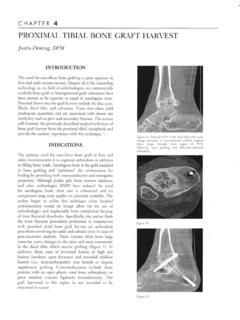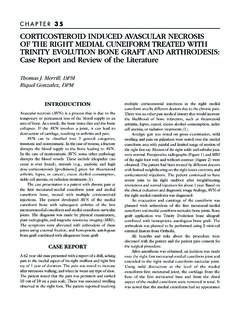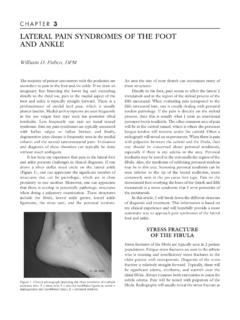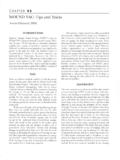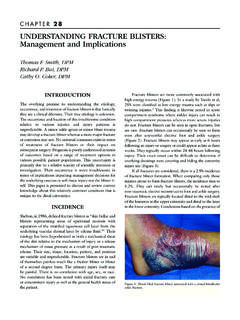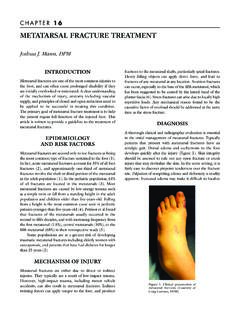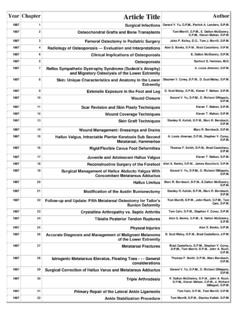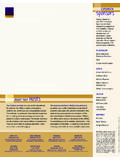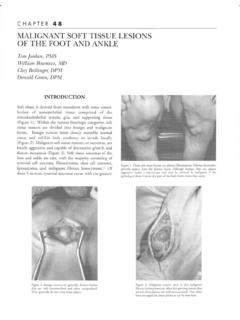Transcription of NEW ORAL ANTICOAGULANTS FOR VENOUS …
1 NEW oral ANTICOAGULANTS FOR VENOUS thromboembolism prophylaxis IN THE FOOT AND ANKLEM atthew Q. McCammon, DPMINTRODUCTIONV enous thromboembolism (VTE) is a common cause of morbidity and mortality. Each year in the US there are approximately 900,000 VTE events and 300,000 deaths as a result of VTEs. The cost of managing VTE is estimated to be as much as $ billion annually (1, 2). For more than 50 years, the only available oral anticoagulant for long-term VTE treatment has been the vitamin K antagonists (Warfarin/Coumadin). However, these agents require bridging, have a narrow therapeutic range, require weekly monitoring, and have several other drawbacks.
2 Over the last several years there have been advancements in the development of new oral anticoagulant medications (NOACs). These drugs originally gained approval for stroke prevention in atrial fi brillation, but have since gained approval for treatment or prophylaxis of VTEs. Vitamin K antagonists exert their effects on the coagulation through the inhibition of Factors II, VII, IX, and X. These new oral drugs prevent VTE by targeting Factor Xa or through direct thrombin inhibition (Figure 1). In the US there are currently 3 such drugs available: 2 Factor Xa inhibitors and one direct thrombin 10 Figure 1.
3 Targets for ANTICOAGULANTS in use and development as thromboprophylaxis after total knee arthroplasty (15).48 FACTOR XA INHIBITORSR ivaroxaban (Xarelto, Janssen Pharmaceuticals)Rivaroxaban is an oral , direct-acting, reversibly selective inhibitor of Factor Xa. It is approved by the Food and Drug Administration (FDA) to reduce the risk of stroke and systemic embolism in patients with nonvalvular atrial fi brillation, treatment of deep vein thrombosis (DVT) and pulmonary embolism (PE) and for reduction of risk of recurrence of DVT and PE, and prophylaxis of DVT, which may lead to PE in patients undergoing knee and hip replacement surgery (3).
4 Rivaroxaban has a rapid onset of action and its pharmacokinetics and pharmacodynamics are dose-proportional. In young, healthy patients elimination half-life at a steady state is 5 to 9 hours and can be up to 10 hours in elderly patients. Its absorption from the gastrointestinal tract is not affected by food. It is eliminated via a dual mode with one-third of the active drug excreted renally in an unchanged form, while the remaining two-thirds undergoes hepatic metabolism. The drug should be avoided in patients with severely impaired renal function (creatinine clearance < 30ml/min) (3).
5 The drug undergoes metabolism via cytochrome isoform CYP3A4. Therefore, the drug is contraindicated with concomitant therapy with potent CYP3A4 inhibitors, such as protease inhibitors, azole antifungals, and macrolide antibiotics. It also interacts with potent inhibitors of P-glycoprotein (p-gp) and is contraindicated with drugs like quinidine. Strong inducers of CYP3A4 and P-gp ( , rifampin, carbamazepine, phenytoin, St. John s Wort) should be avoided because they decrease exposure to the drug and increase risk of VTE and stroke.
6 The most common adverse reaction with rivaroxaban is bleeding (3).When used for VTE prophylaxis following hip and knee replacement surgery, the recommended dose is 10 mg taken orally with or without food. The initial dose should be given at least 6 to 10 hours after surgery once hemostasis has been established. Duration of treatment following hip replacement surgery is 35 days, and treatment duration for knee replacement is 12 days. There are no recommendations for treatment duration outside of hip and knee replacement surgery. If the drug must be discontinued to reduce the risk of bleeding with surgical or other procedures, rivaroxaban should be stopped 24 hours prior to the procedure to reduce the risk of bleeding (3).
7 The Regulation of Coagulation in Orthopedic Surgery to Prevent Deep VENOUS Thrombosis and Pulmonary Embolism (RECORD 1) trial compared the effi cacy and safety of 10 mg of oral rivaroxaban once daily initiated postoperatively, to 40 mg of enoxaparin subcutaneous once daily initiated preoperatively for VTE prevention in 4,541 patients undergoing total hip arthroplasty. The primary effi cacy outcome occurred in of the patients receiving rivaroxaban compared to in those receiving enoxaparin, an absolute risk reduction of (P < ).
8 Major bleeding events occurred in of the rivaroxaban group and in of the patients in the enoxaparin group (P = ) (4).In the RECORD 2 trial extended duration rivaroxaban (31-39 days) was compared to short-term enoxaparin (10-14 days) for total hip arthroplasty in 2,509 patients. Rivaroxaban was associated with a lower risk of VTE and all cause mortality (2%) versus enoxaparin ( ) an absolute risk reduction of (P < ). Major bleeding events were very similar, with in the rivaroxaban group and in the enoxaparin group (P = ) (5).The RECORD 3 trial compared 2,531 knee replacement patients receiving the same dose of either rivaroxaban or enoxaparin.
9 Rivaroxaban was again found to be superior to enoxaparin for VTE prevention and all-cause mortality 13-17 days postoperative, versus , an absolute risk reduction of (P < ). Major bleeding events were again very similar, with in the rivaroxaban group and in the enoxaparin group (6).The RECORD 4 study compared 3,148 knee replacement patients who were randomized to once daily rivaroxaban, 2x 30 mg enoxaparin, or 40 mg of enoxaparin, which was the dose used in previous RECORD studies. Rivaroxaban again showed a signifi cant reduction in primary outcome events ( versus ) with an absolute risk reduction of (P = ), and comparable major bleeding events (rivaroxaban versus enoxaparin , (P = ).)
10 The RECORD trials showed the comparable safety and superior effi cacy of rivaroxaban compared with enoxaparin for VTE prophylaxis after hip and knee replacement surgery (7).Apixaban (Eliquis, Bristol-Myers Squibb)Apixaban, like rivaroxaban, is an oral , direct-acting, selective inhibitor of Factor Xa. It is FDA approved to reduce the risk of stroke and systemic embolism in patients with nonvalvular atrial fi brillation, prophylaxis of DVT following hip and knee replacement surgery, treatment of DVT/PE, and reduction in risk of recurrence. Apixaban has a rapid absorption with a half-life of approximately 12 hours.
